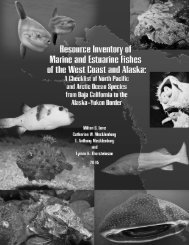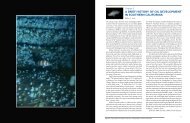Reproductive Ecology and Body Burden of Resident ... - The Love Lab
Reproductive Ecology and Body Burden of Resident ... - The Love Lab
Reproductive Ecology and Body Burden of Resident ... - The Love Lab
Create successful ePaper yourself
Turn your PDF publications into a flip-book with our unique Google optimized e-Paper software.
Table 3. Variation in total length, weight, <strong>and</strong> moisture <strong>of</strong> kelp bass (KBA), kelp rockfish (KRO), <strong>and</strong> Pacific s<strong>and</strong>dab (PSD) sampled<br />
from various sampling sites. a<br />
Site b or F-statistic Total length (cm) Weight (g) Moisture (%)<br />
KBA KRO PSD KBA KRO PSD KBA KRO PSD<br />
PL1 --- 22.9 C 17.8 AB --- 206 BC 59 AB --- 71.1 B 81.2 A<br />
NA1 --- 26.3 ABC 17.0 AB --- 284 BC 53 AB --- 72.1 B 80.5 A<br />
PL2 --- 28.0 AB 17.9 AB --- 376 AB 70 AB --- 70.7 B 80.4 A<br />
NA2 --- 23.3 BC 19.7 AB --- 200 C 83 AB --- 72.5 B 79.9 AB<br />
PL3 --- 22.4 C 21.7 A --- 214 BC 119 A --- 69.8 B 81.8 A<br />
NA3 --- 25.1 ABC 20.4 AB --- 234 BC 92 AB --- 72.5 B 80.0 AB<br />
PL4 34.8 A --- 21.9 A 585 A --- 110 AB 67.3 A --- 79.9 AB<br />
NA4 33.9 A --- 16.0 B 495 A --- 47 B 68.3 A --- 79.7 AB<br />
PL5 --- 30.2 A 21.7 A --- 546 A 124 A --- 82.3 A 79.6 AB<br />
NA5 --- 23.8 BC 20.7 AB --- 199 C 106 AB --- 81.5 A 77.8 B<br />
F (df1,df2)<br />
c,d<br />
0.39 5.39**** 4.04*** 1.76 6.63**** 3.43 ** 1.12 65.65**** 4.77****<br />
a<br />
Within a column, geometric means (total length or weight) or angular-transformed means (moisture) followed by the same capital<br />
letter are not significantly different (P>0.05) according to Tukey’s studentized range test.<br />
b<br />
Names <strong>and</strong> locations <strong>of</strong> sampling sites are given in Table 1.<br />
c<br />
For KBA, df1=1, df2=16; for KRO, df1=7, df2=72; for PSD, df1=9, df2=88.<br />
d<br />
Codes: *, P≤0.05; **; P≤0.01; ***, P≤0.001; ****, P≤0.0001.<br />
Comparisons <strong>of</strong> Quantitative Elements at Oil Platforms <strong>and</strong> Natural Areas<br />
Results from mixed models ANCOVA or ANOVA indicated that none <strong>of</strong> the 21 quantitative elements<br />
consistently exhibited higher concentrations in fish from oil platforms than from natural areas. Out <strong>of</strong><br />
63 possible comparisons (21 elements measured in three fish species), 44 did not reveal significant differences<br />
between HabTypes, whereas 11 comparisons indicated that elemental concentrations were significantly<br />
higher at natural areas than at oil platforms. <strong>The</strong> remaining 8 comparisons exhibited significant<br />
HabType*TL interactions, indicating that relative differences in elemental concentrations between Hab-<br />
Types varied with TL <strong>of</strong> the fish species. Overall, our findings generally fail to support the hypothesis that oil<br />
platforms are major sources <strong>of</strong> trace element contamination in resident marine fishes. Natural hydrocarbon<br />
seeps, which are plentiful in northern portions <strong>of</strong> the Southern California Bight, could expose fish in natural<br />
areas to trace elements <strong>and</strong> other contaminants, thus obfuscating spatial patterns that might otherwise be<br />
attributable to oil platforms. Hornafius et al. (1999) noted that methane <strong>and</strong> non-methane hydrocarbon<br />
emissions from natural seeps are largely responsible for air pollution in Santa Barbara County, <strong>and</strong> that<br />
natural seeps produce oil slicks that evaporate to create abundant “tar balls” found on southern California<br />
beaches. Moreover, in the Southern California Bight, some investigators have suggested that urban run<strong>of</strong>f<br />
might contribute more trace elements (chromium, copper, lead, <strong>and</strong> zinc) <strong>and</strong> nutrients (nitrate <strong>and</strong> phosphorus)<br />
than all other sources combined (Schiff et al. 2000).<br />
13




